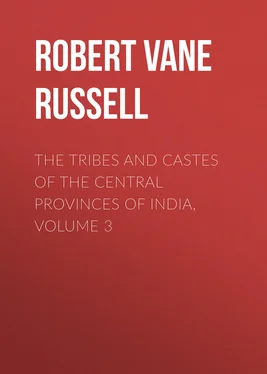Robert Vane Russell - The Tribes and Castes of the Central Provinces of India, Volume 3
Здесь есть возможность читать онлайн «Robert Vane Russell - The Tribes and Castes of the Central Provinces of India, Volume 3» — ознакомительный отрывок электронной книги совершенно бесплатно, а после прочтения отрывка купить полную версию. В некоторых случаях можно слушать аудио, скачать через торрент в формате fb2 и присутствует краткое содержание. Жанр: foreign_prose, История, foreign_edu, foreign_antique, на английском языке. Описание произведения, (предисловие) а так же отзывы посетителей доступны на портале библиотеки ЛибКат.
- Название:The Tribes and Castes of the Central Provinces of India, Volume 3
- Автор:
- Жанр:
- Год:неизвестен
- ISBN:нет данных
- Рейтинг книги:5 / 5. Голосов: 1
-
Избранное:Добавить в избранное
- Отзывы:
-
Ваша оценка:
- 100
- 1
- 2
- 3
- 4
- 5
The Tribes and Castes of the Central Provinces of India, Volume 3: краткое содержание, описание и аннотация
Предлагаем к чтению аннотацию, описание, краткое содержание или предисловие (зависит от того, что написал сам автор книги «The Tribes and Castes of the Central Provinces of India, Volume 3»). Если вы не нашли необходимую информацию о книге — напишите в комментариях, мы постараемся отыскать её.
The Tribes and Castes of the Central Provinces of India, Volume 3 — читать онлайн ознакомительный отрывок
Ниже представлен текст книги, разбитый по страницам. Система сохранения места последней прочитанной страницы, позволяет с удобством читать онлайн бесплатно книгу «The Tribes and Castes of the Central Provinces of India, Volume 3», без необходимости каждый раз заново искать на чём Вы остановились. Поставьте закладку, и сможете в любой момент перейти на страницу, на которой закончили чтение.
Интервал:
Закладка:
4. Occupation
The occupation of the Gārpagāri is to avert hailstorms, and he was formerly remunerated by a customary contribution of rice from each cultivator in the village. He received the usual presents at seed-time and harvest, and two pice from each tenant on the Basant-Panchmi festival. When the sky is of mixed red and black at night like smoke and flame, the Gārpagāri knows that a hailstorm is coming. Then, taking a sword in his hand, he goes and stands before Mahābīr, and begs him to disperse the clouds. When entreaties fail, he proceeds to threats, saying that he will kill himself, and throws off his clothes. Sometimes his wife and children go and stand with him before Mahābīr’s shrine and he threatens to kill them. Formerly he would cut and slash himself, so it is said, if Mahābīr was obdurate, but now the utmost he does is to draw some blood from a finger. He would also threaten to sacrifice his son, and instances are known of his actually having done so.
Two ideas appear to be involved in these sacrifices of the Gārpagāri. One is the familiar principle of atonement, the blood being offered to appease the god as a substitute for the crops which he seems about to destroy. But when the Gārpagāri threatened to kill himself, and actually killed his son, it was not merely as an atonement, because in that case the threats would have had no meaning. His intention seems rather to have been to lay the guilt of homicide upon the god by slaying somebody in front of his shrine, in case nothing less would move him from his purpose of destroying the crops. The idea is the same as that with which people committed suicide in order that their ghosts might haunt those who had driven them to the act. As late as about the year 1905 a Gond Bhumka or village priest was hanged in Chhindwāra for killing his two children. He owed a debt of Rs. 25 and the creditor was pressing him and he had nothing to pay. So he flew into a rage and exclaimed that the gods would do nothing for him even though he was a Bhumka, and he seized his two children and cut off their heads and laid them before the god. In this it would appear that the Bhumka’s intention was partly to take revenge on his master for the neglect shown to him, the god’s special servant. The Gārpagāri diverts the hail by throwing a handful of grain in the direction in which he wishes it to go. When the storm begins he will pick up some hailstones, smear them with his blood and throw them away, telling them to rain over rivers, hills, forests and barren ground. When caterpillars or locusts attack the crops he catches one or two and offers them at Mahābīr’s shrine, afterwards throwing them up in the air. Or he buries one alive and this is supposed to stay the plague. When rust appears in the crops, one or two blades are in like manner offered to Mahābīr, and it is believed that the disease will be stayed. Or if the rice plants do not come into ear a few of them are plucked and offered, and fresh fertile blades then come up. He also has various incantations which are believed to divert the storm or to cause the hailstones to melt into water. In some localities, when the buffalo is slaughtered at the Dasahra festival, the Gārpagāri takes seven different kinds of spring-crop seeds and dips them in its blood. He buries them in a spot beside his hearth, and it is believed that when a hailstorm threatens the grains move about and give out a humming sound like water boiling. Thus the Gārpagāri has warning of the storm. If the Gārpagāri is absent and a storm comes his wife will go and stand naked before Mahābīr’s shrine. The wives know the incantations, but they must not learn them from their husbands, because in that case the husband would be in the position of a guru or spiritual preceptor to his wife and the conjugal relation could no longer continue. No other caste will learn the incantations, for to make the hailstones melt is regarded as equivalent to causing an abortion, and as a sin for which heavy retribution would be incurred in a future life.
In Chhattīsgarh the Baiga or village priest of the aboriginal tribes averts hailstorms in the same manner as the Gārpagāri, and elsewhere the Barais or betel-vine growers perform this function, which is especially important to them because their vines are so liable to be injured by hailstorms. In ancient Greece there existed a village functionary, the Chalazo phulax , who kept off hailstorms in exactly the same manner as the Gārpagāri. He would offer a victim, and if he had none would draw blood from his own fingers to appease the storm. 19 19 Dr. Jevons, Introduction to the History of Religion , p. 171.
The same power has even been imputed to Christian priests as recorded by Sir James Frazer: “In many villages of Provence the priest is still required to possess the faculty of averting storms. It is not every priest who enjoys this reputation; and in some villages when a change of pastors takes place, the parishioners are eager to learn whether the new incumbent has the power ( pouder ) as they call it. At the first sign of a heavy storm they put him to the proof by inviting him to exorcise the threatening clouds; and if the result answers to their hopes, the new shepherd is assured of the sympathy and respect of his flock. In some parishes where the reputation of the curate in this respect stood higher than that of the rector, the relations between the two have been so strained in consequence that the bishop has had to translate the rector to another benefice.” 20 20 The Golden Bough , 2nd ed. vol. i. p. 68, quoting from French authorities.
Of late years an unavoidable scepticism as to the Gārpagāri’s efficiency has led to a reduction of his earnings, and the cultivators now frequently decline to give him anything, or only a sheaf of corn at harvest. Some members of the caste have taken to weaving newār or broad tape for beds, and others have become cultivators.
5. Social status
The Gārpagāris eat flesh and drink liquor. They will take cooked food from a Kunbi, though the Kunbis will not take even water from them. They are a village menial caste and rank with others of the same position, though on a somewhat lower level because they beg and accept cooked food at the weddings of Kunbis. Their names usually end in nāth , as Rāmnāth, Kisannāth and so on.
Gauria
Gauria. 21 21 This article is based on papers by Mr. Jeorākhān Lāl, Deputy Inspector of Schools, Bilāspur, and Bhagwān Singh, Court of Wards Clerk, Bilāspur.
—A small caste of snake-charmers and jugglers who are an offshoot of the Gond tribe. They number about 500 persons and are found only in Chhattīsgarh. They have the same exogamous septs as the Gonds, as Markām, Marai, Netām, Chhedaiha, Jagat, Purteti, Chichura and others. But they are no doubt of very mixed origin, as is shown by the fact that they do not eat together at their feasts, but the guests all cook their own food and eat it separately. And after a daughter has been married her own family even will not take food from her hand because they are doubtful of her husband’s status. It is said that the Gaurias were accustomed formerly to beg only from the Kewat caste, though this restriction is no longer maintained. The fact may indicate that they are partly descended from the unions of Kewats with Gond women.
Adult marriage is the general rule of the caste and a fixed bride-price of sixteen rupees is paid. The couple go away together at once and six months afterwards return to visit the bride’s parents, when they are treated as outsiders and not allowed to touch the food cooked for the family, while they reciprocally insist on preparing their own. Male Gaurias will take food from any of the higher castes, but the women will eat only from Gaurias. They will admit outsiders belonging to any caste from whom they can take food into the community. And if a Gauria woman goes wrong with a member of any of these castes they overlook the matter and inflict only a feast as a penalty.
Читать дальшеИнтервал:
Закладка:
Похожие книги на «The Tribes and Castes of the Central Provinces of India, Volume 3»
Представляем Вашему вниманию похожие книги на «The Tribes and Castes of the Central Provinces of India, Volume 3» списком для выбора. Мы отобрали схожую по названию и смыслу литературу в надежде предоставить читателям больше вариантов отыскать новые, интересные, ещё непрочитанные произведения.
Обсуждение, отзывы о книге «The Tribes and Castes of the Central Provinces of India, Volume 3» и просто собственные мнения читателей. Оставьте ваши комментарии, напишите, что Вы думаете о произведении, его смысле или главных героях. Укажите что конкретно понравилось, а что нет, и почему Вы так считаете.












